Prepare For Impending FSMA Deadlines With The Four "A"s
By Isaac Fletcher, contributing writer, Food Online

FSMA’s finalization is nearly upon us. Food manufacturers should be preparing supply chains and operations to adhere to the new requirements and food-safety standards. Listed below are four, simple actions that can help your operations get up to speed.
Throughout 2014, there was a lot of news and information being released regarding the Food Safety Modernization Act (FSMA) thanks to a steady flow of announcements and guidance from the FDA. The landmark legislation is comprised of seven proposed rules which cover areas such as sanitation, food adulteration, and food-safety audits. With the details shifting and the final proposals not yet finalized, it is difficult for food manufacturers to lay out an effective plan for following these new standards and guidelines.
Related: How To Survive An FDA Audit
In an effort to smooth the process throughout the food industry, the FDA has agreed to court-ordered deadlines wherein it must issue final regulations for all seven rules. The first of these rules must be published by August 30, 2015. The last rule, which deals with international food adulteration, must be finalized by May 31, 2016. Although the second date is a ways away, the FDA has provided adequate guidance on the specifics of the rule to allow companies to start preparing themselves now.
According to Don Hsieh, director of commercial and industrial marketing at Tyco Integrated Security, during planning and preparation for FSMA, food manufacturers should remember the Four "A"s:
- Assess — Assess risks throughout the supply chain by conducting a vulnerability assessment of critical control points and pinpointing areas that could be subject to product adulteration
- Access — Evaluate who has access to the critical control points and pay careful attention to the activities that the FDA has identified as being especially vulnerable to adulteration: mixing and grinding, ingredient handling, bulk liquid receiving and loading, and liquid storage handling
- Alert — Make use of technology to alert appropriate individuals of instances of food adulteration; strive for a rapid response time, as each minute of delay means more potential health risks, negative impacts on brand identity, and danger to public safety
- Audit — Conduct audits to ensure both operational and regulatory compliance to maintain best food defense practices and provide important documentation to regulating bodies
The goal of FSMA is to promote food safety by focusing on prevention instead of reactive response. By becoming an early adopter and taking and implementing a proactive food defense strategy, the transition into the era of FSMA will be much less daunting.
